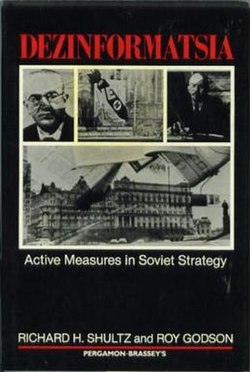Disinformation is a subset of propaganda and is false information that is spread deliberately to deceive. It is also known as black propaganda. It is sometimes confused with misinformation, which is false information but is not deliberate.

Black propaganda is a form of propaganda intended to create the impression that it was created by those it is supposed to discredit. Black propaganda contrasts with grey propaganda, which does not identify its source, and white propaganda, which does not disguise its origins at all. It is typically used to vilify or embarrass the enemy through misrepresentation.
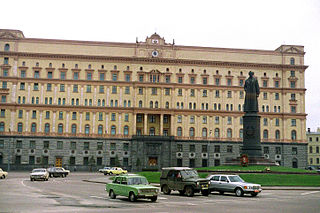
Active measures is political warfare conducted by the Soviet or Russian government since the 1920s. It includes offensive programs such as disinformation, propaganda, deception, sabotage, destabilization, subversion, and espionage. The programs were based on foreign policy priorities of the Soviet Union.
As early as the 1920s, the Soviet Union, through its GRU, OGPU, NKVD, and KGB intelligence agencies, used Russian and foreign-born nationals, as well as Communists of American origin to perform espionage activities in the United States, forming various spy rings. Particularly during the 1940s, some of these espionage networks had contact with various U.S. government agencies. These Soviet espionage networks illegally transmitted confidential information to Moscow, such as information on the development of the atomic bomb. Soviet spies also participated in propaganda and disinformation operations, known as active measures, and attempted to sabotage diplomatic relationships between the U.S. and its allies.

Operation Neptune was a 1964 disinformation operation by the Czechoslovak secret service, the StB, involving Nazi-era documents.
An agent of influence is an agent of some stature who uses his or her position to influence public opinion or decision making to produce results beneficial to the country whose intelligence service operates the agent. Agents of influence are often the most difficult agents to detect, as there is seldom material evidence that connects them with a foreign power, but they can be among the most effective means of influencing foreign opinion and actions as they hold considerable credibility among the target audience. Most commonly they serve the interests of a foreign power in one of three ways: either as a controlled agent directly recruited and controlled by a foreign power; as a "trusted contact" that consciously collaborates to advance foreign interests but is not directly recruited or controlled by a foreign power; or as a "useful idiot" that is completely unaware of how their actions further the interests of a foreign power.
According to the Estonian Internal Security Service, Russian influence operations in Estonia form a complex system of financial, political, economic and espionage activities in Republic of Estonia for the purposes of influencing Estonia's political and economic decisions in ways considered favourable to Russian Federation and conducted under the doctrine of near abroad. The Russian government has actively pursued the imposition of a dependent relationship upon the Baltic states, with the desire to remain the region's dominant actor and political arbiter, continuing the Soviet pattern of hegemonic relations with these small neighbouring states. According to the Centre for Geopolitical Studies, the Russian information campaign which the centre characterises as a "real mud throwing" exercise, has provoked a split in Estonian society amongst Russian speakers, inciting some to riot over the relocation of the Bronze Soldier. The 2007 cyberattacks on Estonia is considered to be an information operation against Estonia, with the intent to influence the decisions and actions of the Estonian government. While Russia denies any direct involvement in the attacks, hostile rhetoric from the political elite via the media influenced people to attack.

Operation INFEKTION was the popular name given to an active measure disinformation campaign run by the KGB in the 1980s to plant the idea that the United States had invented HIV/AIDS as part of a biological weapons research project at Fort Detrick, Maryland. Historian Thomas Boghardt popularized the codename "INFEKTION" based on the claims of former East German Ministry for State Security (Stasi) officer Günter Bohnsack, who claimed that the Stasi codename for the campaign was either "INFEKTION" or perhaps also "VORWÄRTS II". However, historians Christopher Nehring and Douglas Selvage found in the former Stasi and Bulgarian State Security archives materials that prove the actual Stasi codename for the AIDS disinformation campaign was Operation "DENVER". The operation involved "an extraordinary amount of effort — funding radio programs, courting journalists, distributing would-be scientific studies", according to journalist Joshua Yaffa, and even became the subject of a report by Dan Rather on the CBS Evening News.
Denial and deception (D&D) is a Western theoretical framework for conceiving and analyzing military intelligence techniques pertaining to secrecy and deception. Originating in the 1980s, it is roughly based on the more pragmatic Soviet practices of maskirovka but it has a more theoretical approach compared to the latter.
The Interagency Active Measures Working Group was a group led by the United States Department of State and later by the United States Information Agency (USIA). The group was formed early during the Reagan administration, in 1981, as an effort to counter aggressive Soviet disinformation.
Herbert "Herb" Romerstein was an American ex-communist and historian who became a writer specializing in anticommunism and was appointed Director of the U.S. Information Agency’s Office to Counter Soviet Disinformation and Active Measures. As an author he is best known for his book The Venona Secrets.

Political warfare is the use of political means to compel an opponent to do one's will, based on hostile intent. The term political describes the calculated interaction between a government and a target audience, including another state's government, military, and/or general population. Governments use a variety of techniques to coerce certain actions, thereby gaining relative advantage over an opponent. The techniques include propaganda and psychological operations (PsyOps), which service national and military objectives respectively. Propaganda has many aspects and a hostile and coercive political purpose. Psychological operations are for strategic and tactical military objectives and may be intended for hostile military and civilian populations.
The Fletcher School's International Security Studies Program is a center for the study of international security studies and security policy development. It was established in 1971 at The Fletcher School of Law and Diplomacy, Tufts University. ISSP conducts its academic activity through courses, simulations, conferences, and research. It also has a military fellows program for midcareer U.S. officers.

Richard H. Shultz, Jr. is an American scholar of international security studies. He is a Professor International Politics at The Fletcher School of Law and Diplomacy, Tufts University, where he is also the director of the International Security Studies Program (ISSP).
Lawrence Martin-Bittman, formerly known as Ladislav Bittman, was an American artist, author, and retired professor of disinformation at Boston University. Prior to his defection to the United States in 1968, he served as an intelligence officer specializing in disinformation for the Czechoslovak Intelligence Service.
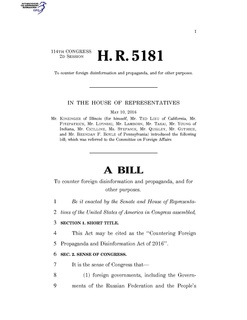
Countering Foreign Propaganda and Disinformation Act is a bipartisan bill that was introduced by the United States Congress on 10 May 2016. The bill was initially called the Countering Information Warfare Act.
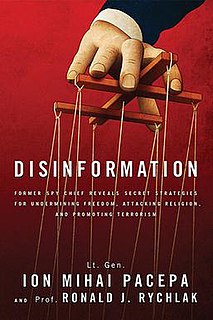
Disinformation: Former Spy Chief Reveals Secret Strategies for Undermining Freedom, Attacking Religion, and Promoting Terrorism is a non-fiction book about disinformation tactics and history rooted in information warfare. It was written by former general in the Securitate, the secret police of Socialist Republic of Romania, Ion Mihai Pacepa, and law professor Ronald J. Rychlak. It was published in 2013 along with a companion film, Disinformation: The Secret Strategy to Destroy the West.

The KGB and Soviet Disinformation: An Insider's View is a non-fiction book about the KGB's use of disinformation and information warfare during the Soviet Union period. It was written by former intelligence officer specializing in disinformation for the Czech Intelligence Service and retired professor of disinformation at Boston University, Ladislav Bittman.

Roy Godson is an academic and scholar within the fields of international politics and national security, and a professor emeritus at Georgetown University.
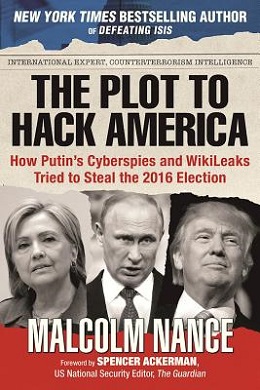
The Plot to Hack America: How Putin's Cyberspies and WikiLeaks Tried to Steal the 2016 Election is a non-fiction book by Malcolm Nance about what the author describes as Russian interference in the 2016 United States elections. It was published in paperback, audiobook, and e-book formats in 2016 by Skyhorse Publishing. A second edition was also published the same year, and a third edition in 2017. Nance researched Russian intelligence, working as a Russian interpreter and studying KGB history.
